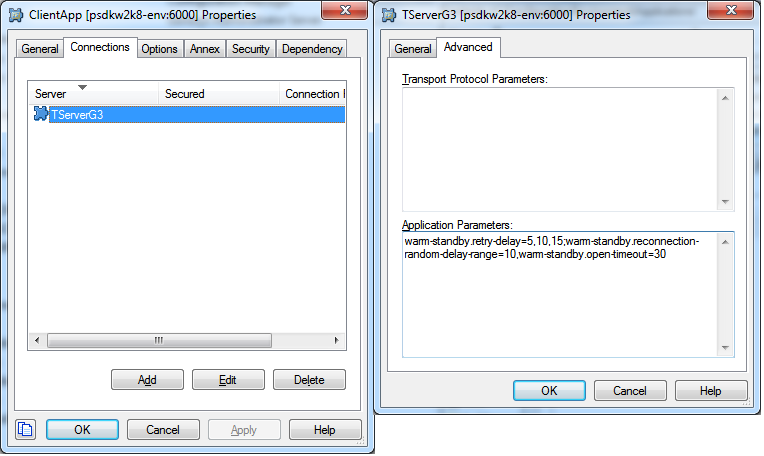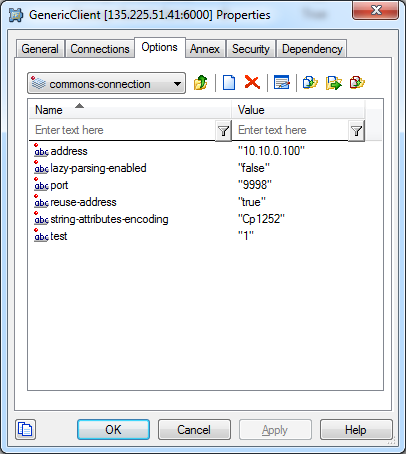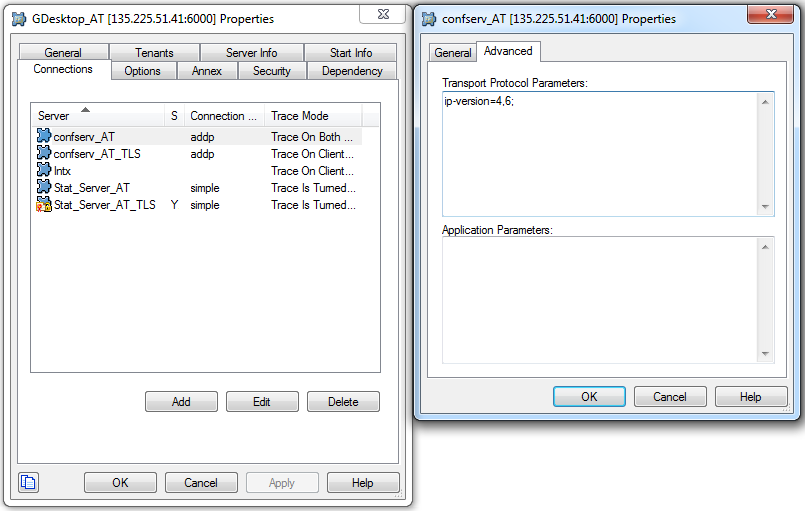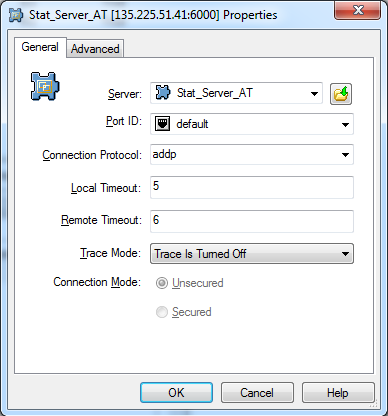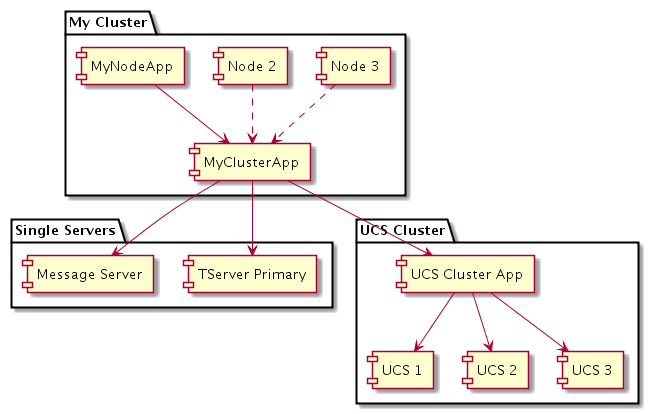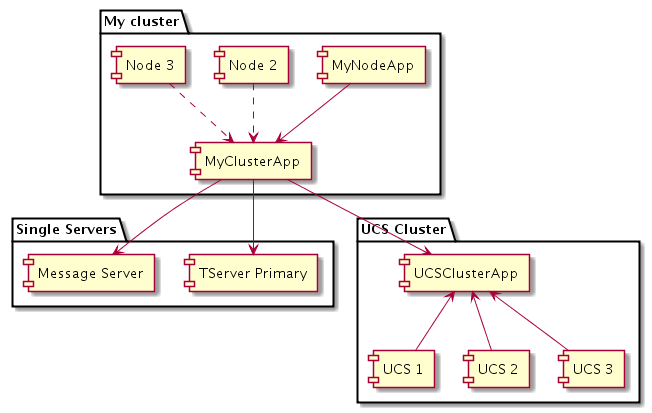Disclaimer: This code is supplied to you by Genesys Telecommunications Laboratories Inc ("Genesys") in consideration of your agreement to the following terms, and your use, installation, modification or redistribution of this Genesys software constitutes acceptance of these terms. If you do not agree with these terms, please do not use, install, modify or redistribute this Genesys software.
In consideration of your agreement to abide by the following terms, and subject to these terms, Genesys grants you a personal, non-exclusive license, under Genesys's copyrights in this original Genesys software (the "Genesys Software"), to use, reproduce, modify and redistribute the Genesys Software, with or without modifications, in source and/or binary forms; provided that if you redistribute the Genesys Software in its entirety and without modifications, you must retain this notice and the following text and disclaimers in all such redistributions of the Genesys Software.
Neither the name, trademarks, service marks or logos of Genesys Inc. may be used to endorse or promote products derived from the Genesys Software without specific prior written permission from Genesys. Except as expressly stated in this notice, no other rights or licenses, express or implied, are granted by Genesys herein, including but not limited to any patent rights that may be infringed by your derivative works or by other works in which the Genesys Software may be incorporated.
The Genesys Software is provided by Genesys on an "AS IS" basis. GENESYS MAKES NO WARRANTIES, EXPRESS OR IMPLIED, INCLUDING WITHOUT LIMITATION THE IMPLIED WARRANTIES OF NON-INFRINGEMENT, MERCHANTABILITY AND FITNESS FOR A PARTICULAR PURPOSE, REGARDING THE GENESYS SOFTWARE OR ITS USE AND OPERATION ALONE OR IN COMBINATION WITH YOUR PRODUCTS.
IN NO EVENT SHALL GENESYS BE LIABLE FOR ANY SPECIAL, INDIRECT, INCIDENTAL OR CONSEQUENTIAL DAMAGES (INCLUDING, BUT NOT LIMITED TO, PROCUREMENT OF SUBSTITUTE GOODS OR SERVICES; LOSS OF USE, DATA, OR PROFITS; OR BUSINESS INTERRUPTION) ARISING IN ANY WAY OUT OF THE USE, REPRODUCTION, MODIFICATION AND/OR DISTRIBUTION OF THE GENESYS SOFTWARE, HOWEVER CAUSED AND WHETHER UNDER THEORY OF CONTRACT, TORT (INCLUDING NEGLIGENCE), STRICT LIABILITY OR OTHERWISE, EVEN IF GENESYS HAS BEEN ADVISED OF THE POSSIBILITY OF SUCH DAMAGE.
Copyright (C) 2014 Genesys Inc. All Rights Reserved.
Using the Application Template Application Block
Please see the License Agreement for details.
The Application Template Application Block provides a way to read configuration options for applications in Genesys Administrator and to configure Platform SDK protocols. It also allows standard connection settings (including ADDP or TLS details) to be retrieved from Configuration Server, and helps with common features like setting up WarmStandby or assigning message filters. Primary Application Template functionality includes:
- ClientConfigurationHelper sets up client connections and configures WarmStandby.
- ServerConfigurationHelper sets up server connections.
- GConfigTlsPropertyReader extracts TLS-related option values from configuration objects, and is intended to be used together with com.genesyslab.platform.commons.connection.tls.TLSConfigurationParser.
- FilterConfigurationHelper helps to bind message filters with protocol objects.
- GFApplicationConfigurationManager monitors the application configuration from Configuration Server and provides notification of any updates to options for your custom application, options of connected servers, or options of their host objects. If Log4j2 logging framework exists, then this component also enables Log4j2 configuration based on the application logging options in Configuration Manager. For more information, refer to the Additional Logging Features article.
- ClusterClientConfigurationHelper helps create and configure the Cluster Protocol Application Block.
Setting Up a Client Connection
Application Template helper creates com.genesyslab.platform.Endpoint instance with initialized configuration properties. Details about how to specify required options in Configuration server are available below. In order to retrieve specified options from Configuration Server, user should read IGApplicationConfiguration object where this properties are stored.
Sample:
//create Configuration Service
ConfServerProtocol confProtocol = new ConfServerProtocol(new Endpoint(host,port));
confProtocol.setUserName("...");
confProtocol.setClientName("...");
confProtocol.setClientApplicationType(CfgAppType.CFGSCE.ordinal());
IConfService confService = ConfServiceFactory.createConfService(confProtocol);
confProtocol.open();
//read your application options
String appName = "my-app-name";
CfgApplication cfgApplication = confService.retrieveObject(CfgApplication.class,
new CfgApplicationQuery(appName));
GCOMApplicationConfiguration appConfiguration = new
GCOMApplicationConfiguration(cfgApplication);
//get particular connection definition
IGAppConnConfiguration connConfig = appConfiguration.getAppServer(CfgAppType.CFGStatServer);
//returns configured endpoint.
Endpoint epStatSrv = ClientConfigurationHelper.createEndpoint(appConfiguration,
connConfig, connConfig.getTargetServerConfiguration());
//use protocol with configured endpoint
StatServerProtocol statProtocol = new StatServerProtocol(epStatSrv);
statProtocol.setClientName(clientName);
statProtocol.open();Configuring WarmStandby
| Note: This section was updated for Platform SDK for Java release 8.5.102.02. For earlier releases, expand the "Legacy Content" text at the end of this section. |
The Application Template helper createWarmStandbyConfigEx() allows you to create a configuration for the new implementation of the warm standby, as illustrated here:
String appName = "my-app-name"
CfgApplication cfgApplication = confService.retrieveObject(
CfgApplication.class, new CfgApplicationQuery(appName));
GCOMApplicationConfiguration appConfiguration =
new GCOMApplicationConfiguration(cfgApplication);
IGAppConnConfiguration connConfig = appConfiguration.getAppServer(CfgAppType.CFGStatServer);
//Helper method for new WarmStandby
WSConfig wsConfig = ClientConfigurationHelper.createWarmStandbyConfigEx(appConfiguration, connConfig);
StatServerProtocol statProtocol = new StatServerProtocol();
statProtocol.setClientName(clientName);
WarmStandby warmStandby = new WarmStandby(statProtocol);
warmStandby.setConfig(wsConfig);
warmStandby.autoRestore();Configuration in Configuration Manager looks quite similar to the classic Warm Standby configuration with one difference: there are special timing parameters which are quite different than "Reconnection Timeout" and "Reconnection Attempts" and thus are specified apart from them. The "Reconnection Timeout" and "Reconnection Attempts" are not used in new Warm Standby Configuration.
Client Connection options:
| Name | Values, in Seconds |
|---|---|
| warm-standby.retry-delay | 5, 10, 15 |
| warm-standby.reconnection-random-delay-range | 10 |
| warm-standby.open-timeout | 30 |
See Warm Standby documentation and the API Reference guide for details about how these timing options customize Warm Standby behavior.
Options can be specified in Configuration Manager as shown below:
The last option is specified in Backup Server Applications on the Options tab. This characteristic of the backup server describes how much time is required for the server to step into primary mode.
| Options Tab Section | Value, in Seconds |
|---|---|
| warm-standby | backup-delay=5 |
Setting Up a Server Channel
Similar to the creation of the client connection, provide the IGApplicationConfiguration object to the helper class.
Sample:
Endpoint endpoint = ServerConfigurationHelper.createListeningEndpoint(appConfiguration, appConfiguration.getPortInfo("default"));
ExternalServiceProtocolListener serverChannel = new ExternalServiceProtocolListener(endpoint);This helper creates an Endpoint instance initialized with properties like the listening TCP port number, ADDP parameters, and so on.
Setting Up TLS
Instructions on how to enable TLS using the Application Template Application Block are part of the TLS-specific documentation. Please refer to that article for details about how to enable secure connections using the Application Template.
Also, see how to Configure TLS Parameters in Configuration Manager for a client or server channel.
Enabling Message Filtering
Using the Debug Log Level in Platform SDK protocol may affect Application performance due to the huge amount of log information output. It is possible to setup message filters for a protocol object, where the filter is configured in Genesys Administrator. This way, production applications will be able to provide appropriate log traces for troubleshooting without hurting performance with overly verbose logging.
See how to setup message filters for additional details.
Defining Configuration Options in Genesys Administrator
Options can be specified in the CfgApplication object using Genesys Administrator. There are several possible option locations in the CfgApplication object:
- Options tab
- Annex tab
- Connections parameters
- Port parameters
- Host annex
Common Options
Here is how options could be specified on the Options tab:
Here is how options could be specified for a particular connection (using the Connection parameters):
A complete options list is provided in the table below.
| Section | Option | Description |
|---|---|---|
| commons-connection | string-attributes-encoding | Specifies encoding for string attributes. |
| lazy-parsing-enabled | Boolean value. Enables or disables lazy parsing of properties, for which lazy parsing possibility is enabled in protocol.
Currently used in Configuration Server protocol, enabled by default. | |
| address | Host bind option, specifies host from which connection should be made | |
| port | Port bind option, specifies port from which connection should be made | |
| backup-port | Port bind option, specifies port from which connection should be made (bind to) for backup server. | |
| operation-timeout | Integer value. Timeout for operations like stopReading and resumeReading.
Timeout is specified in milliseconds. | |
| connection-timeout | Integer value. Sets connection timeout option for the local socket to be opened by connection.
Timeout is specified in milliseconds. | |
| reuse-address | Boolean value. Sets SO_REUSEADDR option for the local socket to be opened by connection | |
| keep-alive | Boolean value. Sets SO_KEEPALIVE option for the local socket to be opened by connection. | |
| ucs-protocol | use-utf-for-responses | Boolean value. If set to false, UCSprotocol will add 'tkv.multibytes'='false' pair in Request KVlist of the message. It is false by default. |
| use-utf-for-requests | Boolean value. If set to true, all string values of each KVlist will be packed as UtfStrings (in "UTF-16BE" encoding), instead of common strings. It is true by default. | |
| webmedia-protocol | target-xml-version | Version of XML which is used to transport WebMedia protocol messages.
See corresponding javax.xml.transform.OutputKeys.Version property for details. |
| replace-illegal-unicode-chars | Boolean value. Enables or disables replacing of the illegal unicode chars in Webmedia XML messages. | |
| illegal-unicode-chars-replacement | String to replace illegal unicode chars |
IPV6 Options
The IPV6 usage can be enabled with "enable-ipv6" option.
| Section | Option | Description |
|---|---|---|
| common | enable-ipv6 | Turns IPv6 support on/off.
Possible values: 0 (default, implied) and 1. If set to 0, IPv6 support would be disabled, even if supported by OS/platform. |
The ip-version constant specifies the order in which connection attempts will be made to IPv6 and IPv4 addresses. Possible values include the following strings:
- "4,6" (default)
- "6,4"
This setting has no effect on the connection if enable-ipv6 is set to 0; warning would be logged. Has no effect on server side; warning would be logged.
Option values should be specified within the connection transport properties:
ADDP Options
ADDP options, which can be handled with the Application Template helper, should be specified on the Connections tab.
TLS Options
See the article on Configuring TLS Parameters in Configuration Manager for more information about TLS options.
Cluster Connection Configuration Helpers
This section describes Application Template helper methods that support the configuration of cluster connections to Genesys server, including use cases and samples.
Cluster Connection Configuration Types
There are two types of Genesys server cluster configuration available in Configuration Server: client-aligned configuration, and node-aligned configuration.
Both types provide information about addresses of the target servers in a cluster, and connection options used to communicate with them. You must choose the proper helper to use for each type of cluster configuration.
Client-aligned configuration methods:
- ClusterClientConfigurationHelper.createClusterProtocolEndpoints(IGApplicationConfiguration appConfig, CfgAppType serverType)
- ClusterClientConfigurationHelper.createClusterProtocolEndpoints(IGApplicationConfiguration appConfig, IGAppConnConfiguration clusterConn, CfgAppType serverType)
Node-aligned configuration methods:
- ClusterClientConfigurationHelper.createRefClusterProtocolEndpoints(IConfService confService, IGApplicationConfiguration appConfig, CfgAppType serverType)
- ClusterClientConfigurationHelper.createRefClusterProtocolEndpoints(IConfService confService, IGApplicationConfiguration appConfig, IGAppConnConfiguration clusterConn, CfgAppType serverType)
Client-Aligned Configuration Samples
Sample 1
In the first sample scenario, a "ClientApp" Application is connected to the "ClusterApp'" virtual application (type=CFGApplicationCluster) that has connections to cluster nodes of one ore more clusters.
ClusterProtocol protocol ...
List<WSConfig> nodesList = ClusterClientConfigurationHelper.createClusterProtocolEndpoints(ClientApp, CfgAppType.CFGContactServer);
protocol.setNodes(nodesList);Sample 2
In the second sample scenario, the "MyNodeApp" Application is a cluster node that is connected to the "MyClusterApp" virtual application. In this case, "MyClusterApp" is a shared store of connection configurations for all cluster nodes, which can have connections to other clusters like "UCS" as well as stand-alone servers.
ClusterProtocol protocol ...
List<WSConfig> nodesList = ClusterClientConfigurationHelper.createClusterProtocolEndpoints(MyClusterApp, clusterAppConnection, CfgAppType.CFGContactServer);
protocol.setNodes(nodesList);Connection Options
You can use Genesys Administrator to define connection parameter options (such as ADDP, ip-version, strings encoding, or TCP socket options) that are used for all nodes in a cluster, or to define connection parameter for a particular node that will overriding common parameters.
- Common Options: Specified in the connection from ClientApp to ClusterApp (or from OwnClusterApp if application is a node of some type of cluster).
- Node-Specific Options: can be specified in Configuration Manager in connection from ClusterApp to NodeApp.
See eServices Load Balancing Business Continuity for examples.
Node-Aligned Configuration
Sample 3
In the third sample scenario, the "ClientApp" Application is connected to the "UCSClusterApp" virtual application that groups UCS nodes. Unlike previous configurations, the cluster nodes in this scenario are also connected to the "UCSClusterApp" virtual application.
ClusterProtocol protocol ...
List<WSConfig> nodesList = ClusterClientConfigurationHelper.createRefClusterProtocolEndpoints(confService, ClientApp, CfgAppType.CFGContactServer);
protocol.setNodes(nodesList);Sample 4
In the fourth sample scenario, the "MyNodeApp" Application is a cluster node. The "MyClusterApp" application has a connection to the UCS cluster ("UCSClusterApp" application). UCS nodes also have connections to "UCSClusterApp".
ClusterProtocol protocol ...
List<WSConfig> nodesList = ClusterClientConfigurationHelper.createRefClusterProtocolEndpoints(confService, MyNodeApp, clusterAppConnection, CfgAppType.CFGContactServer);
protocol.setNodes(nodesList);Connection Options
You can use Genesys Administrator to define connection parameter options (such as ADDP, ip-version, strings encoding, or TCP socket options), but in this scenario this configuration is applied for all nodes in a cluster.
- Common Options: Specified in the connection from ClientApp to ClusterApp.
Client Connection Active Nodes Randomizer
The randomizer helper component supports cluster load balancing from client applications, by allowing your applications to work with a server cluster without creating live connections to all of its nodes. This also prevents many clients from being stuck on a single connection, to resolve issues such as a single server overloading on startup, and can be of critical importance in use cases where the number of clients could be in the tens of thousands.
This helper takes a list of cluster nodes, and performs periodical endpoint rotation. The existing Cluster Protocol functionality to update its nodes configuration dynamically..
For each new node that is added:
- a new instance of the related PSDK protocol class is created
- asynchronous open is started
- after the node has connected to its server, the node is added to load balancer
For each node that is removed:
- the removed node is immediately excluded from the load balancer
- the node is scheduled to be closed after its protocol timeout delay (which allows responses to be delivered for in-progress requests)
The randomizer uses the Collections.shuffle(nodes) method to randomize the sequence of given nodes.When updating the protocol node configuration, the randomizer uses a round-robin rotation over a whole list of randomly-sorted cluster nodes, choosing a subset of given number of elements. This allows the protocol to avoid breaking all connections at a single moment, and to stay online during switchover.
The randomizer component also has an optional ability to attach truncated nodes' endpoints as backup endpoints for selected ones. This allows the internal WarmStandby service to quickly switchover from an unresponsive node.
Sample usage of this component could look like the following:
final UcsClusterProtocol ucsNProtocol = new UcsClusterProtocolBuilder().build();
List<WSConfig> nodes = ...;
ClusterNodesShuffler shuffler = new ClusterNodesShuffler(ucsNProtocol, 2); // creates nodes shuffler for 2 active connections
shuffler.setUseBackups(true); // - lets the shuffler to use truncated nodes endpoints as backup endpoints for the selected ones
shuffler.setNodes(nodes); // - initializes shuffler with the whole list of cluster nodes
ucsNProtocol.open();
TimerActionTicket shufflerTimer = TimerFactory.getTimer().schedule(3000, 3000, shuffler); // - schedules shuffling operation with 3 secs delay and 3 secs period
// Do the business logic on the cluster protocol...
// In case of update in the cluster configuration, application should use 'shuffler.setNodes(newNodes)'
// instead of ClusterProtocol's methods related to nodes configuration.
// Shutdown:
shufflerTimer.cancel();
ucsNProtocol.close();Code Samples
Simple Client Application Connecting to Any UCS Cluster
This sample checks the connection configuration for "WCC mode" UCS 9.0 cluster, then for "WDE mode" UCS cluster, and then for "legacy mode" connection to UCS (pri/bck) server.
// Take "my application configuration" from context, or read it in a way like this:
IGApplicationConfiguration myApp = new GCOMApplicationConfiguration(
confService.retrieveObject(CfgApplication.class,
new CfgApplicationQuery(myAppName)));
// For the first, try UCS 9 connection cluster:
List<WSConfig> conns = ClusterClientConfigurationHelper.createRefClusterProtocolEndpoints(
confService, myApp, CfgAppType.CFGContactServer);
if (conns == null || conns.isEmpty()) {
// If there is no UCS 9 cluster connected, then we try older UCS cluster, or simple UCS connection(s):
conns = ClusterClientConfigurationHelper.createClusterProtocolEndpoints(
myApp, CfgAppType.CFGContactServer);
}
System.out.println("Connections: " + conns);WCC-Based Cluster Node Application Connecting to Any UCS Cluster
This sample works in context of WCC.
// Take "my application configuration" from context, or read it in a way like this:
final IGApplicationConfiguration myApp = new GCOMApplicationConfiguration(
confService.retrieveObject(CfgApplication.class,
new CfgApplicationQuery(myAppName)));
IGApplicationConfiguration myClusterApp = null;
// if we do not have 'myClusterApp' from WCC context, we may take it by this way:
final List<IGAppConnConfiguration> clusters = GApplicationConfiguration
.getAppServers(myApp.getAppServers(), CfgAppType.CFGApplicationCluster);
if (clusters != null) {
if (clusters.size() == 1) {
myClusterApp = clusters.get(0).getTargetServerConfiguration();
log.infoFormat(
"Application is recognized as a node of cluster ''{0}''",
myClusterApp.getApplicationName());
} else if (clusters.size() > 1) {
log.error("Application has more than one application cluster connected"
+ " - its treated as a standalone app");
}
}
// Select application cluster connection start point:
final IGApplicationConfiguration connSrc = (myClusterApp != null) ? myClusterApp : myApp;
// For the first, try UCS 9 connection cluster:
List<WSConfig> conns = ClusterClientConfigurationHelper.createRefClusterProtocolEndpoints(
confService, connSrc, CfgAppType.CFGContactServer);
if (conns == null || conns.isEmpty()) {
// If there is no UCS 9 cluster connected, then we try older UCS cluster, or simple UCS connection(s):
conns = ClusterClientConfigurationHelper.createClusterProtocolEndpoints(
connSrc, CfgAppType.CFGContactServer);
}
System.out.println("Connections: " + conns);Client Nodes Randomizer Usage Sample
Application code using the randomizer component may look like the following sample:
final List<WSConfig> nodes = ...;
final UcsClusterProtocol ucsNProtocol =
new UcsClusterProtocolBuilder()
.build();
ucsNProtocol.setTimeout(5000); // sets protocol timeout to 5 secs
ucsNProtocol.setClientName("MyClientName");
ucsNProtocol.setClientApplicationType("MyAppType");
ClusterNodesShuffler shuffler = new ClusterNodesShuffler(ucsNProtocol, 2); // creates nodes shuffler for 2 active connections
TimerActionTicket shufflerTimer = null;
try {
shuffler.setNodes(nodes); // - initializes shuffler with the whole list of cluster nodes.
ucsNProtocol.open();
shufflerTimer = TimerFactory.getTimer().schedule(3000, 3000, shuffler); // - schedules shuffling operation with 3 secs delay and 3 secs period
// do the business logic on the cluster protocol...
for (int i = 0; i < 200; i++) {
EventGetVersion resp = (EventGetVersion) ucsNProtocol.request(RequestGetVersion.create());
System.err.println("Resp from: " + resp.getEndpoint());
Thread.sleep(300);
}
} finally {
if (shufflerTimer != null) {
shufflerTimer.cancel();
shufflerTimer = null;
}
ucsNProtocol.close();
}Handling Updates From Config Server
The GFApplicationConfigurationManager component monitors Config Server for updates and provides notifications about changes in applications.
You should register for updates at GFApplicationConfigurationManager.
GFApplicationConfigurationManager appManager = ...
appManager.register(new ClientConnEventListener());
appManager.init();In the handle (GFAppCfgEvent event) method implementation, create a new connection configuration using one of the helpers mentioned above:
import com.genesyslab.platform.apptemplate.application;
public class ClientConnEventListener extends GFAppCfgEventListener {
private UcsClusterProtocol ucsProtocol;
@Override
public void handle(GFAppCfgEvent event) {
//get new application configuration
IGApplicationConfiguration appconfig = event.getAppConfig();
//create new connection configuration
List<WSConfig> conns = ClusterClientConfigurationHelper.createClusterProtocolEndpoints(appconfig, CfgAppType.CFGContactServer);
//apply connection configuration
ucsProtocol.setNodes(conns);
}
}The Application Template Application Block provides a way to read configuration options for applications in Genesys Administrator and to configure Platform SDK protocols. It also allows standard connection settings (including ADDP or TLS details) to be retrieved from Configuration Server, and helps with common features like setting up WarmStandby or assigning message filters. Primary Application Template functionality includes:
- ClientConfigurationHelper sets up client connections and configures WarmStandby.
- ServerConfigurationHelper sets up server connections.
Setting Up a Client Connection
Application Template helper creates an Endpoint instance with initialized configuration properties. Details about how to specify required options in Configuration server are available below. In order to retrieve specified options from Configuration Server, user should read IGApplicationConfiguration object where this properties are stored.
Sample:
//create Configuration Service
ConfServerProtocol confProtocol = new ConfServerProtocol(new Endpoint(host,port)){
UserName = "...",
ClientName = "...",
ClientApplicationType= (int)cfgAppType,
UserPassword = "..."
};
IConfService confService = ConfServiceFactory.CreateConfService(confProtocol);
confProtocol.Open();
//read your application options
var myApplicationName = "...";
var applicationConfiguration = new GCOMApplicationConfiguration(
new CfgApplicationQuery(confService){ Name = myApplicationName }.ExecuteSingleResult() );
CfgAppType myApplicationType = default(CfgAppType);
var applicationEndPoint = ClientConfigurationHelper.CreateEndpoint(applicationConfiguration,
applicationConfiguration.GetAppServer(myApplicationType),
applicationConfiguration.GetAppServer(myApplicationType).TargetServerConfiguration);
//use protocol with configured endpoint
StatServerProtocol statProtocol = new StatServerProtocol(applicationEndPoint);
statProtocol.ClientName = clientName;
statProtocol.Open();Configuring WarmStandby
The Application Template helper CreateWarmStandbyConfigEx() allows you to create a configuration for the new implementation of the warm standby, as illustrated here:
var myApplicationName = "…";
CfgAppType myApplicationType = default(CfgAppType);
var applicationConfiguration = new GCOMApplicationConfiguration(
new CfgApplicationQuery(confService){ Name = myApplicationName }.ExecuteSingleResult() );
WSConfig warmStandbyConfig = ClientConfigurationHelper.CreateWarmStandbyConfigEx(
applicationConfiguration,applicationConfiguration.GetAppServer(myApplicationType));Configuration in Configuration Manager looks quite similar to the classic Warm Standby configuration with one difference: there are special timing parameters which are quite different than "Reconnection Timeout" and "Reconnection Attempts" and thus are specified apart from them. The "Reconnection Timeout" and "Reconnection Attempts" are not used in new Warm Standby Configuration.
Client Connection options:
| Name | Values, in Seconds |
|---|---|
| warm-standby.retry-delay | 5, 10, 15 |
| warm-standby.reconnection-random-delay-range | 10 |
| warm-standby.open-timeout | 30 |
See Warm Standby documentation and the API Reference guide for details about how these timing options customize Warm Standby behavior.
Options can be specified in Configuration Manager as shown below:
The last option is specified in Backup Server Applications on the Options tab. This characteristic of the backup server describes how much time is required for the server to step into primary mode.
| Options Tab Section | Value, in Seconds |
|---|---|
| warm-standby | backup-delay=5 |
Setting Up a Server Channel
Similar to the creation of the client connection, provide the IGApplicationConfiguration object to the helper class.
Sample:
Endpoint endpoint = ServerConfigurationHelper.CreateListeningEndpoint(appConfiguration, appConfiguration.PortInfo("default"));
ExternalServiceProtocolListener serverChannel = new ExternalServiceProtocolListener(endpoint);This helper creates an Endpoint instance initialized with properties like the listening TCP port number, ADDP parameters, and so on.
Defining Configuration Options in Genesys Administrator
Options can be specified in the CfgApplication object using Genesys Administrator. There are several possible option locations in the CfgApplication object:
- Application options tab
- Connection parameters
- Port parameters
Common Options
Here is how options could be specified on the Options tab:
Here is how options could be specified for a particular connection (using the Connection parameters):
A complete options list is provided in the table below.
| Section | Option | Description |
|---|---|---|
| commons-connection | string-attributes-encoding | Specifies encoding for string attributes. |
| lazy-parsing-enabled | Boolean value. Enables or disables lazy parsing of properties, for which lazy parsing possibility is enabled in protocol.
Currently used in Configuration Server protocol, enabled by default. | |
| address | Host bind option, specifies host from which connection should be made | |
| port | Port bind option, specifies port from which connection should be made | |
| backup-address | Host bind option, specifies host from which connection should be made for backup server. | |
| backup-port | Port bind option, specifies port from which connection should be made (bind to) for backup server. | |
| ucs-protocol | use-utf-for-responses | Boolean value. If set to false, UCSprotocol will add 'tkv.multibytes'='false' pair in Request KVlist of the message. It is false by default. |
| use-utf-for-requests | Boolean value. If set to true, all string values of each KVlist will be packed as UtfStrings (in "UTF-16BE" encoding), instead of common strings. It is true by default. | |
| webmedia-protocol | replace-illegal-unicode-chars | Boolean value. Enables or disables replacing of the illegal unicode chars in Webmedia XML messages. |
| illegal-unicode-chars-replacement | String to replace illegal unicode chars |
IPV6 Options
The IPV6 usage can be enabled with "enable-ipv6" option.
| Section | Option | Description |
|---|---|---|
| common | enable-ipv6 | Turns IPv6 support on/off.
Possible values: 0 (default, implied) and 1. If set to 0, IPv6 support would be disabled, even if supported by OS/platform. |
The ip-version constant specifies the order in which connection attempts will be made to IPv6 and IPv4 addresses. Possible values include the following strings:
- "4,6" (default)
- "6,4"
This setting has no effect on the connection if enable-ipv6 is set to 0; warning would be logged. Has no effect on server side; warning would be logged.
Option values should be specified within the connection transport properties:
ADDP Options
ADDP options, which can be handled with the Application Template helper, should be specified on the Connections tab.
TLS Options
See the article on Configuring TLS Parameters in Configuration Manager for more information about TLS options.
Cluster Connection Configuration Helpers
This section describes Application Template helper methods that support the configuration of cluster connections to Genesys server, including use cases and samples.
Cluster Connection Configuration Types
There are two types of Genesys server cluster configuration available in Configuration Server: client-aligned configuration, and node-aligned configuration.
Both types provide information about addresses of the target servers in a cluster, and connection options used to communicate with them. You must choose the proper helper to use for each type of cluster configuration.
Client-aligned configuration methods:
- ClusterClientConfigurationHelper.CreateClusterProtocolEndpoints(IGApplicationConfiguration appConfig, CfgAppType serverType)
- ClusterClientConfigurationHelper.CreateClusterProtocolEndpoints(IGApplicationConfiguration appConfig, IGAppConnConfiguration clusterConn, CfgAppType serverType)
Node-aligned configuration methods:
- ClusterClientConfigurationHelper.CreateRefClusterProtocolEndpoints(IConfService confService, IGApplicationConfiguration appConfig, CfgAppType serverType)
- ClusterClientConfigurationHelper.CreateRefClusterProtocolEndpoints(IConfService confService, IGApplicationConfiguration appConfig, IGAppConnConfiguration clusterConn, CfgAppType serverType)
Client-Aligned Configuration Samples
Sample 1
In the first sample scenario, a "ClientApp" Application is connected to the "ClusterApp'" virtual application (type=CFGApplicationCluster) that has connections to cluster nodes of one ore more clusters.
IClusterProtocol protocol ...
IList<WSConfig> nodesList = ClusterClientConfigurationHelper.CreateClusterProtocolEndpoints(ClientApp, CfgAppType.CFGContactServer);
protocol.SetNodes(nodesList);Sample 2
In the second sample scenario, the "MyNodeApp" Application is a cluster node that is connected to the "MyClusterApp" virtual application. In this case, "MyClusterApp" is a shared store of connection configurations for all cluster nodes, which can have connections to other clusters like "UCS" as well as stand-alone servers.
IClusterProtocol protocol ...
IList<WSConfig> nodesList = ClusterClientConfigurationHelper.CreateClusterProtocolEndpoints(MyClusterApp, clusterAppConnection, CfgAppType.CFGContactServer);
protocol.SetNodes(nodesList);Connection Options
You can use Genesys Administrator to define connection parameter options (such as ADDP, ip-version, strings encoding, or TCP socket options) that are used for all nodes in a cluster, or to define connection parameter for a particular node that will overriding common parameters.
- Common Options: Specified in the connection from ClientApp to ClusterApp (or from OwnClusterApp if application is a node of some type of cluster).
- Node-Specific Options: can be specified in Configuration Manager in connection from ClusterApp to NodeApp.
See eServices Load Balancing Business Continuity for examples.
Node-Aligned Configuration
Sample 3
In the third sample scenario, the "ClientApp" Application is connected to the "UCSClusterApp" virtual application that groups UCS nodes. Unlike previous configurations, the cluster nodes in this scenario are also connected to the "UCSClusterApp" virtual application.
IClusterProtocol protocol ...
IList<WSConfig> nodesList = ClusterClientConfigurationHelper.CreateRefClusterProtocolEndpoints(confService, ClientApp, CfgAppType.CFGContactServer);
protocol.SetNodes(nodesList);Sample 4
In the fourth sample scenario, the "MyNodeApp" Application is a cluster node. The "MyClusterApp" application has a connection to the UCS cluster ("UCSClusterApp" application). UCS nodes also have connections to "UCSClusterApp".
IClusterProtocol protocol ...
IList<WSConfig> nodesList = ClusterClientConfigurationHelper.CreateRefClusterProtocolEndpoints(confService, MyNodeApp, clusterAppConnection, CfgAppType.CFGContactServer);
protocol.SetNodes(nodesList);Connection Options
You can use Genesys Administrator to define connection parameter options (such as ADDP, ip-version, strings encoding, or TCP socket options), but in this scenario this configuration is applied for all nodes in a cluster.
- Common Options: Specified in the connection from ClientApp to ClusterApp.
Client Connection Active Nodes Randomizer
The randomizer helper component supports cluster load balancing from client applications, by allowing your applications to work with a server cluster without creating live connections to all of its nodes. This also prevents many clients from being stuck on a single connection, to resolve issues such as a single server overloading on startup, and can be of critical importance in use cases where the number of clients could be in the tens of thousands.
This helper takes a list of cluster nodes, and performs periodical endpoint rotation. The existing Cluster Protocol functionality to update its nodes configuration dynamically..
For each new node that is added:
- a new instance of the related PSDK protocol class is created
- asynchronous open is started
- after the node has connected to its server, the node is added to load balancer
For each node that is removed:
- the removed node is immediately excluded from the load balancer
- the node is scheduled to be closed after its protocol timeout delay (which allows responses to be delivered for in-progress requests)
The randomizer uses the Collections.shuffle(nodes) method to randomize the sequence of given nodes.When updating the protocol node configuration, the randomizer uses a round-robin rotation over a whole list of randomly-sorted cluster nodes, choosing a subset of given number of elements. This allows the protocol to avoid breaking all connections at a single moment, and to stay online during switchover.
The randomizer component also has an optional ability to attach truncated nodes' endpoints as backup endpoints for selected ones. This allows the internal WarmStandby service to quickly switchover from an unresponsive node.
Sample usage of this component could look like the following:
IList<WSConfig> nodes = ...;
UcsClusterProtocol ucsNProtocol = new UcsClusterProtocolBuilder().Build();
var shuffler = new ClusterNodesShuffler(ucsNProtocol, 2); // creates nodes shuffler for 2 active connections
shuffler.UseBackups = true;// - lets the shuffler to use truncated nodes endpoints as backup endpoints for the selected ones
try {
shuffler.SetNodes(nodes); // - initializes shuffler with the whole list of cluster nodes.
ucsNProtocol.Open();
shuffler.StartTimer(3000, 3000); // - schedules shuffling operation with 3 secs delay and 3 secs period
// Do the business logic on the cluster protocol...
// In case of update in the cluster configuration, application should use 'shuffler.SetNodes(newNodes)'
// instead of ClusterProtocol's methods related to nodes configuration.
} finally {
shuffler.StopTimer();
ucsNProtocol.Close();
}Code Samples
Simple Client Application Connecting to Any UCS Cluster
This sample checks the connection configuration for "WCC mode" UCS 9.0 cluster, then for "WDE mode" UCS cluster, and then for "legacy mode" connection to UCS (pri/bck) server.
// Take "my application configuration" from context, or read it in a way like this:
ConfServerProtocol cfgProtocol=new ConfServerProtocol(new Endpoint(host, port));
IConfService confService=ConfServiceFactory.CreateConfService(cfgProtocol);
IGApplicationConfiguration myApp = new GCOMApplicationConfiguration(
new CfgApplicationQuery(confService){Name = "myAppName"}.ExecuteSingleResult());
// For the first, try UCS 9 connection cluster:
IList<WSConfig> conns = ClusterClientConfigurationHelper.CreateRefClusterProtocolEndpoints(
confService, myApp, CfgAppType.CFGContactServer);
if ((conns == null) || (conns.Count==0)) {
// If there is no UCS 9 cluster connected, then we try older UCS cluster, or simple UCS connection(s):
conns = ClusterClientConfigurationHelper.CreateClusterProtocolEndpoints(
myApp, CfgAppType.CFGContactServer);
}
Console.WriteLine("Connections: " + conns);WCC-Based Cluster Node Application Connecting to Any UCS Cluster
This sample works in context of WCC.
var cfgProtocol=new ConfServerProtocol(new Endpoint(host, port));
var confService=ConfServiceFactory.CreateConfService(cfgProtocol);
// Take "my application configuration" from context, or read it in a way like this:
IGApplicationConfiguration myApp = new GCOMApplicationConfiguration(
new CfgApplicationQuery(confService){Name = "myAppName"}.ExecuteSingleResult());
IGApplicationConfiguration myClusterApp = null;
// if we do not have 'myClusterApp' from WCC context, we may take it by this way:
IList<IGAppConnConfiguration> clusters = GApplicationConfiguration.GetAppServers(myApp.AppServers, CfgAppType.CFGApplicationCluster);
if (clusters != null) {
if (clusters.Count == 1) {
myClusterApp = clusters[0].TargetServerConfiguration;
log.InfoFormat("Application is recognized as a node of cluster ''{0}''",myClusterApp.ApplicationName);
} else if (clusters.Count > 1) {
log.Error("Application has more than one application cluster connected - its treated as a standalone app");
}
}
// Select application cluster connection start point:
IGApplicationConfiguration connSrc = myClusterApp ?? myApp;
// For the first, try UCS 9 connection cluster:
IList<WSConfig> conns = ClusterClientConfigurationHelper.CreateRefClusterProtocolEndpoints(
confService, connSrc, CfgAppType.CFGContactServer);
if (conns == null || conns.Count==0) {
// If there is no UCS 9 cluster connected, then we try older UCS cluster, or simple UCS connection(s):
conns = ClusterClientConfigurationHelper.CreateClusterProtocolEndpoints(
connSrc, CfgAppType.CFGContactServer);
}
Console.WriteLine("Connections: " + conns);Client Nodes Randomizer Usage Sample
Application code using the randomizer component may look like the following sample:
IList<WSConfig> nodes = ...;
UcsClusterProtocol ucsNProtocol = new UcsClusterProtocolBuilder().Build();
ucsNProtocol.Timeout = TimeSpan.FromSeconds(5); // sets protocol timeout to 5 secs
ucsNProtocol.ClientName = "MyClientName";
ucsNProtocol.ClientApplicationType = "MyAppType";
var shuffler = new ClusterNodesShuffler(ucsNProtocol, 2); // creates nodes shuffler for 2 active connections
try {
shuffler.SetNodes(nodes); // - initializes shuffler with the whole list of cluster nodes.
ucsNProtocol.Open();
shuffler.StartTimer(3000, 3000); // - schedules shuffling operation with 3 secs delay and 3 secs period
// do the business logic on the cluster protocol...
for (int i = 0; i < 200; i++)
{
var resp = ucsNProtocol.Request(RequestGetVersion.Create()) as EventGetVersion;
if (resp!=null) Console.WriteLine("Resp from: " + resp.Endpoint);
Thread.Sleep(300);
}
} finally {
shuffler.StopTimer();
ucsNProtocol.Close();
}Handling Updates From Config Server
The GFApplicationConfigurationManager component monitors Config Server for updates and provides notifications about changes in applications.
You should register for updates at GFApplicationConfigurationManager.
In the handle (GFAppCfgEvent event) method implementation, create a new connection configuration using one of the helpers mentioned above:
using Genesyslab.Platform.AppTemplate.Application;
UcsClusterProtocol ucsProtocol = ...;
GFApplicationConfigurationManager appManager = ...;
appManager.Register(@event =>
{
//get new application configuration
IGApplicationConfiguration appconfig = @event.AppConfig;
//create protocol config
var wsconfig = ClusterClientConfigurationHelper.CreateClusterProtocolEndpoints(appconfig, CfgAppType.CFGContactServer);
//apply new set of protocol endpoints
ucsProtocol.SetNodes(wsconfig );
});
appManager.Init();
